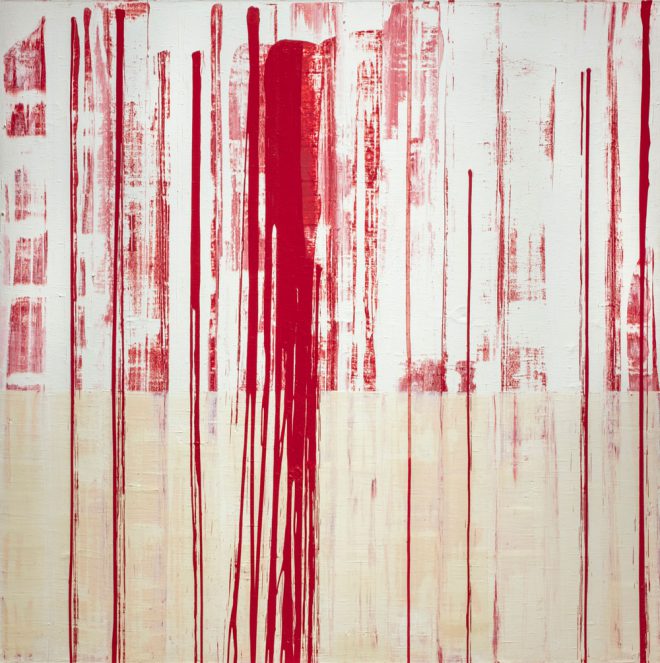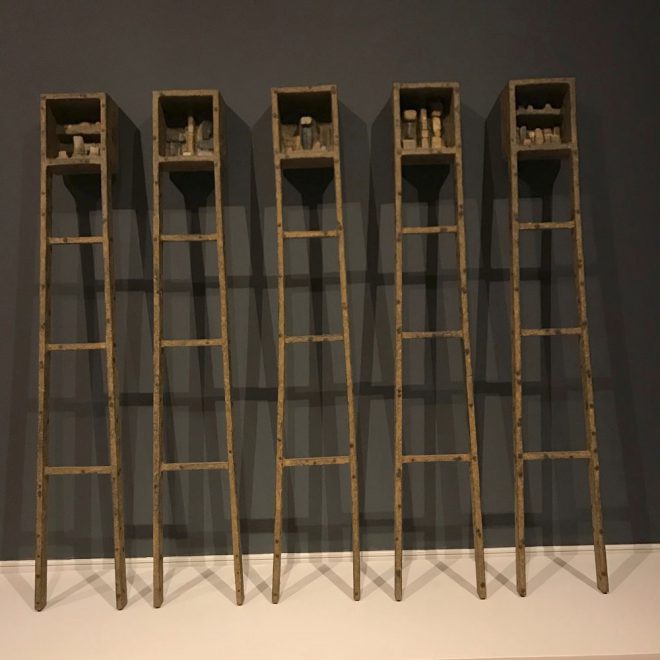Thunderous Noise: “The Whole Drum Will Sound” at the Ogden Museum of Southern Art
Taylor Murrow visits an exhibition at the Ogden Museum of Southern Art and considers the legacy of female abstract artists in the South.

Jacqueline Humphries, Red and White Abstraction, Untitled #3, 1995. Oil on linen. Courtesy the artist and Greene Naftali, New York. Collection of the Ogden Museum of Southern Art, New Orleans.
Many people would recognize the iconic splatters of Jackson Pollock’s work, or the soft rectangular forms of Mark Rothko’s paintings. The men of Abstract Expressionism have enjoyed great renown in the world of art. Their work is well represented in museums and books, and throughout pop culture. Women working in abstraction have had more of a challenge gaining proper recognition throughout their careers, despite their contributions to the field. And those who have gained a high level of recognition are too often viewed in the context of their relationships to male artists, i.e. Lee Krasner to her husband Pollock, Helen Frankenthaler to her husband Robert Motherwell, etc.
Luckily, New Orleanians get to experience an inspiring selection of abstract works by Southern women in the Ogden Museum of Southern Art’s current exhibition “The Whole Drum Will Sound: Women in Southern Abstraction.” Curator Bradley Sumrall has included works by contemporary artists as well as artists working half a century ago, though they are largely separated by their placement in two different galleries. Nonetheless, the newer voices sing in tune with those of the women who came before them, though their approaches to abstraction may differ. Viewers are treated to the trompe l’oeil of Bonnie Maygarden’s Virtuous Reality I, 2013, and the playful exuberance of Ashley Teamer’s Don’t Let the Door Hitcha Where the Good Lord Splitcha, 2012, as well as the rich, symbolic language of Ida Kohlmeyer, who famously taught another icon of Louisiana abstraction, Lynda Benglis.
On view in one of the fifth-floor galleries, Shawne Major’s colossal mixed-media assemblage Eating Cake, 2008, is an intoxicating collection of kitschy objects. Margaret Evangeline’s painted work on aluminum from 2004 is pocked with faux bullet holes. Displayed in a wall-sized grid, Shawn Hall’s BIO logy paintings, 2006, look like writhing microscopic organisms, the elaborate, magnified contents of a petri dish. Vincencia Blount used negative space masterfully in her abstractions on view here, both from 1968, seemingly chiseling across the canvas with bold, sharp lines. Sculptural works shine, too. Lake Stilts, c. 1968, by Clyde Connell (created when the artist was 84 years old) stands in the gallery like long-lost totems discovered in a bayou, while Connell’s dancer sculptures evoke movement in their spindly forms.

Clyde Connell, Lake Stilts, c. 1968. Mixed media on wood. Collection of the Ogden Museum of Southern Art, New Orleans.
Female artists can’t be pigeonholed into one theme or aesthetic, but that’s not what “The Whole Drum” is trying to do. There is value in showing that there is a history of talented female artists working in abstraction in the South, and that this legacy continues with each generation. There are some imaginative, visionary works of art worth seeing in this show, and that’s enough in itself.
The Ogden Museum takes the name of this exhibition from Lebanese-French author Amin Maalouf’s book In the Name of Identity: Violence and the Need to Belong: “A person’s identity is not an assemblage of separate affiliations, nor a kind of loose patchwork; it is like a pattern drawn on a tightly stretched parchment. Touch just one part of it, just one allegiance, and the whole person will react, the whole drum will sound.” Though part of a pre-9/11 commentary on relations between Western and Middle Eastern cultures, Maalouf’s quote makes for an interesting exhibition title choice here in examining the interconnectedness between identity and selfhood and its dangers. Perhaps viewers are being instructed to recognize these artists for their individual styles while acknowledging that there is a unity—and strength—in their shared allegiance as women working in the South.
As a woman born and raised in the South, I found myself invigorated by the works that surrounded me at the Ogden. There was something incredibly uplifting about being encircled by compelling, exhilarating art by women, many pieces rendered in bold hues that seemed to radiate in defiance of a world that may have tried to silence their makers. “The Whole Drum” asks viewers to consider those who have been excluded from certain art-historical narratives, despite their skill—and which artists are being overlooked today. Individually, women’s voices may have been easily quelled in the past, but collectively, our noise can be thunderous.
Editor's Note
“The Whole Drum Will Sound” is on view through July 22, 2018, at the Ogden Museum of Southern Art (925 Camp Street) in New Orleans.



